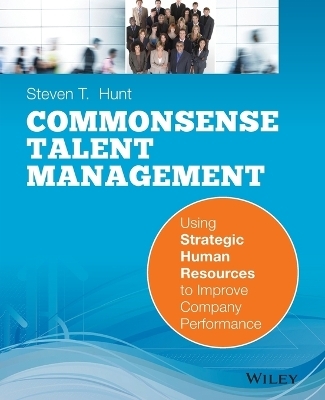
Common Sense Talent Management
Pfeiffer (Verlag)
978-0-470-44241-8 (ISBN)
Steven Hunt, Ph.D., is Director of Business Transformation Services at SuccessFactors. He has over 15 years experience designing talent management solutions supporting a range of applications including performance management, staffing, employee development, culture change, workforce transformation, and succession planning. An active author and speaker, he regularly presents at industry and academic conferences and via webinars funded by human capital management organizations. His articles have appeared in dozens of trade and academic journals ranging from the Wall Street Journal to the International Journal of Selection & Assessment. He is also author of a book on the applied use of staffing assessment methods entitled "Hiring Success" (Pfeiffer). Hunt held research and consulting positions with Kronos Talent Management Division, Starbucks, SHL Inc., Personnel Decisions International, and the Department of Energy National Laboratories. He resides in Portland, OR.
Tables, Figures, and Discussions xi
Preface xvii
One Why Read This Book? The Good, the Great, and the Stupidus Maximus Award 1
1.1 How This Book Is Structured 8
1.2 The Role of HR Technology in Strategic HR 9
1.3 Why This Book Matters 14
Two Strategic HR: What It Is, Why It Is Important, and Why It Is Often Difficult 15
2.1 The Fundamental Processes of Strategic HR 17
2.2 Why Do We Need Strategic HR Departments? 20
2.3 What Makes Strategic HR Difficult? 21
2.4 Conclusion 24
Three Business Execution and Strategic HR 27
3.1 Defining Business Execution 27
3.2 Assessing Business Execution Needs 31
3.3 Using Strategic HR Processes to Support Business Execution 39
3.4 Linking Specific Business Execution Drivers to Different HR Processes 41
3.5 Increasing Strategic HR Process Maturity 43
3.5.1 Right People Maturity Levels 44
3.5.2 Right Things Maturity Levels 45
3.5.3 Right Way Maturity Levels 45
3.5.4 Right Development 46
3.6 Integrating Strategic HR Processes 46
3.7 Conclusion 56
Four Right People: Designing Recruiting and Staffing Processes 59
4.1 Recruiting to Support Business Execution 60
4.1.1 Quality of Hiring Decisions 62
4.1.2 Quality of Sourcing 64
4.1.3 Relationships and Networking 64
4.1.4 Hiring Manager Involvement 65
4.1.5 Integrated Talent Management 66
4.2 Critical Recruiting Design Questions 67
4.2.1 What Types of Jobs Are We Hiring For? 68
4.2.2 How Many People Will We Need to Hire, and When Will We Need Them? 70
4.2.3 What Sort of Employees Do We Need to Hire? What Attributes Do Candidates Need to Possess to Become Effective Employees? 74
4.2.4 What Roles Will Hiring Managers, Recruiters, Coworkers, and Candidates Play in the Hiring Process? 79
4.2.5 How Will We Source Candidates? 83
4.2.6 How Will We Select Candidates? 89
4.2.7 How Will We Get Newly Hired Employees Up to Full Productivity? 93
4.2.8 How Will We Retain Employees after They Are Hired? 94
4.2.9 How Will We Measure Recruiting Success and Improve Our Processes over Time? 94
4.3 Recruiting Process Maturity 96
4.4 Conclusion 97
Five Doing the Right Things: Becoming a Goal-Driven Organization 101
5.1 What It Means to Be a “Goal-Driven” Organization 104
5.2 The Role of Goals in an Integrated Strategic HR System 107
5.3 Goal Management Critical Design Questions 111
5.3.1 How Will You Ensure Employees Have Well-Defined Goal Plans? 111
5.3.2 What Are You Doing to Ensure Employees Feel a Sense of Commitment and Ownership toward the Goals They Are Assigned? 120
5.3.3 What Methods Are Used to Align Employees’ Goals with Company Business Strategies? 124
5.3.4 How Is Employee Goal Accomplishment Measured? 131
5.3.5 What Is the Relationship between Goal Accomplishment and Employee Pay, Promotions, and Recognition? 133
5.3.6 How Are Goals Used to Support Employee Development and Career Growth? 137
5.3.7 How Does the Organization Coordinate Goals across Different Employees to Foster Communication and Collaboration? 141
5.3.8 How Are Goals Used to Guide Business Execution on an Ongoing Basis? 142
5.4 Goal Management Process Maturity 145
5.5 Conclusion 148
Six Doing Things the Right Way: Using Performance Management to Increase Business Execution 151
6.1 Why Is Performance Management So Difficult? 152
6.2 Why Do We Need Performance Management? 158
6.3 Balancing the Conflicting Goals of Performance Management 159
6.4 Critical Performance Management Design Questions 161
6.4.1 What Are the Primary Objectives of Your Performance Management Process? 162
6.4.2 How Do You Define Effective Performance? 168
6.4.3 How Will You Structure Your Performance Management Cycle? When Will You Evaluate Performance? 183
6.4.4 How Will You Evaluate Performance? 190
6.4.5 How Will You Calibrate Performance Evaluations? 211
6.4.6 How Are Data from Performance Evaluations Used? What Is the Relationship among Performance Evaluations, Pay, Promotions, Development, and Workforce Management? 220
6.4.7 What Training and Incentives Do Managers and Employees Need to Effectively Use Performance Management Processes? 230
6.5 Increasing Performance Management Process Maturity 242
6.6 Conclusion 244
Seven Creating the Right Development Experiences 249
7.1 The Basic Components of a Development Process 252
7.2 The Six Primary Development Methods 255
7.3 Approaching Development Programs from an Integrated Perspective 257
7.3.1 All Development Methods Should Leverage Other Development Methods 259
7.3.2 All Development Methods Use Roles, Relationships, and Resources to Achieve Learning Objectives 261
7.3.3 Development Is Most Effective When It Is Built Directly into Business Operations 263
7.3.4 Integrated Development as a Way of Thinking 266
7.4 Critical Development Design Questions 266
7.4.1 What Talent Requirements Are You Addressing? 267
7.4.2 What Positions or People Do You Need to Develop? 271
7.4.3 What Employee Attributes Do You Need to Develop in Order to Achieve Your Learning Objectives? 274
7.4.4 How Will You Build and Maintain Development Methods? 280
7.4.5 How Will You Administer and Support Development Methods? 284
7.4.6 How Will You Measure the Impact of Development Programs? 287
7.4.7 How Will You Create an Environment That Supports Use of Development Methods? 293
7.5 Increasing Development Process Maturity 299
7.6 Conclusion 304
Eight Creating an Integrated HR Strategy 307
8.1 Identifying the Change You Want to Create 309
8.2 Defining What the Change Will Look Like 314
8.3 Defining How You Will Create and Measure the Change 319
8.4 Operationalizing the Change 323
8.5 Conclusion 327
Nine Strategic HR Process Deployment and Adoption 329
9.1 Establishing HR Leadership Credibility 330
9.2 Defining the Change and Change Requirements 334
9.3 Providing Tools and Training to Support the Change 337
9.3.1 How Technology Enables Change 337
9.3.2 Branding HR Processes 344
9.4 Enlisting Line Leadership to Drive the Change 345
9.5 Conclusion 347
Ten Improving the World through Strategic HR 349
10.1 Next Steps 351
10.2 Parting Thoughts 352
Acknowledgments 355
Appendix A: A Comprehensive Library of Behavioral Competencies 357
Appendix B: Building a Robust Succession Management Process 389
Glossary of Common Strategic Human Resource Terms 401
About the Author 427
Index 429
| Sprache | englisch |
|---|---|
| Maße | 178 x 234 mm |
| Gewicht | 635 g |
| Themenwelt | Wirtschaft ► Betriebswirtschaft / Management ► Personalwesen |
| ISBN-10 | 0-470-44241-7 / 0470442417 |
| ISBN-13 | 978-0-470-44241-8 / 9780470442418 |
| Zustand | Neuware |
| Haben Sie eine Frage zum Produkt? |
aus dem Bereich


